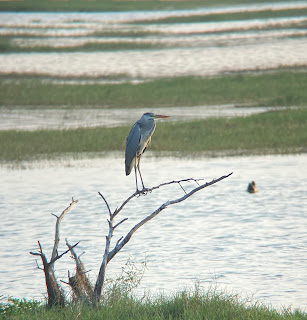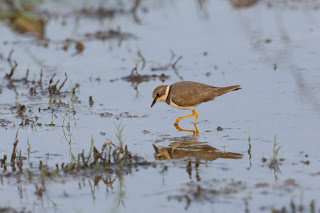Author: Ravi Kailas
Lingambudhi Kere (23rd Feb 21', 0720 to 1020)
This south Mysore lake, located amidst a newly developing area of an expanding city, has the richest bird diversity among the city’s ebird hotspots. Not surprising given that it is an oasis of relatively pristine wetland and forest habitat (with some excellent patches of mature bamboo), in a yet sparsely populated suburb of the city.
Entering through a nondescript gate in the East, a few minutes after sunrise, we were greeted by a cacophony of bird sound emerging from a large, fruit bearing Banyan Tree. Ticking off the usual suspects - White-cheeked and Coppersmith Barbets and Indian Grey Hornbill, the most obvious this morning - that feast on this manna from heaven, in this part of the world, we proceeded along a trail with the lake on one side and farmland on the other, but not before the author was attacked by a colony of weaver ants, cunningly hidden in the leaf litter, that clambered up his legs, at least one finding its way into the unmentionables (in this forum at least) and making its presence felt, provoking a frenzied effort to ‘dust’ them off myself, in what must have been an awkward to somewhat humorous spectacle depending on the individual onlookers sensibilities. I digress, and getting back on track, this small, relatively open section of the path revealed a buzz ‘little brown bird’ (warblers/prinias) activity in the reeds along the lake/lower bushes, as well as some commoner wetland species, a flock of Western Yellow Wagtail, seemingly in migration, in a fallow field, an Asian Brown Flycatcher and birds like Ashy Drongo, Indian Golden Oriole, Common Iora and Small Minivet in the canopy beyond. About 200m further down, the path enters an alluringly deep, dark, bamboo forest, but not before passing an upcoming residential colony, and a stream of sewerage emanating from the development, flowing into the lake, suggesting a potential vulnerability for this relatively pristine green space in the not too distant future. Spot-breasted Fantail were numerous here, and there was also a healthy population of Tickell’s Blue Flycatcher, Blyth’s Reed Warbler and Indian Paradise Flycatcher (in in their magical breeding plumage). The highlights though, in the bamboo patch were of a Blue-throated Blue Flycatcher, a winter visitor to these parts, and a group of Tawny-bellied Babbler foraging in low bushes of an unkempt garden, where the bamboo forest met the outside world. Further on, bamboo gave way to an open forest of tall trees with a weedy undergrowth. This habitat produced sightings of Blue-faced Malkoha, and few wetland birds in the adjacent lake, including Garganey and Northern Shoveler (numerous) - our first ducks of the morning. It was around now, about two hours since we started our amble, with the morning sun bright and increasingly warm, when we started to wonder when we would complete the loop. We managed to stumble upon the much more popular and manicured gardens around the the main entrance to the lake, and some kind folks there pointed out the direction to a couple of other exits, one of it where our car was parked potentially, the farthest one as it turned out. Gathering pace, thoughts of breakfast vying for space with birds, and winning, we walked through a drier, scrubbier habitat where birds like Indian Robin began to appear. This led to a gate adjacent to a main road that hugs the lake that eventually led to our vehicle. Walking along this road produced our final species of the morning - two distant raptors riding the thermals of the late morning heat, which turned out to be a pair of the delightful Oriental Honey Buzzard.
An afternoon drive along the Mysore-Manathavadi Road (23rd Feb 21', PM)
One of the wonderful upsides of Mysore's location is the ease with which one can access biodiverse, wildlife rich natural areas, in the Cauvery basin of the Western and Eastern Ghats. One such place, 80km southwest of Mysore is Kabini, on the eastern fringes of Nagarhole Tiger Reserve. This relatively compact tourism zone is now world famous as one of the best places on Earth to see leopards, including, of late, a melanistic individual, and tigers, on a regular basis along with a healthy population of megafauna typical of peninsular India, its fame amply enhanced by its proximity to the social media wildlife photographer central that Bangalore is. With fame though, there is an inevitable deterioration of aesthetics, the zoo like atmosphere created by the clamour to see big cats, while ignoring...sullying even, the charm of the wilderness (glorious sunsets by the backwaters in summer, the grassy banks dotted with herds of elephant, gaur, deer., those refreshing April thundershowers, often accompanied by hail, the verdant forest after few monsoon showers, the charm of spring, bird song, trees flowering in a leafless, brown forest, in the peak of the dry season, the misty winter mornings...). I reminisce here to my first visit to this wildlife haven, on a family holiday more than 30 years ago, to a time that there was only one resort, often with just two jeeps entering the forest in a safari session, when we could stop and smell the roses ... err.... carcasses, get excited by alarm calls and pug marks, stop under a fruiting tree to bird, spend an entire summer evening lakeside, watching the herds of elephants go about their business ... everything at a more relaxed pace, enjoying the jungle in its entirety. This became, still is, an annual pilgrimage for our family, every visit inevitably throwing up a rarity, at that time, a tiger seen across a watchtower, a leopard sitting out a thunderstorm on a tree branch across a game road, a pair of sloth bear crossing the game road at dusk, a Rock Python nesting in a hollow of a fallen tree trunk, but none of them as easy to find, often requiring patience and tracking/spotting skills, as necessary to find animals that would rather not be found. Over time big cat sightings have become more regular, virtually every outing these days, as families of felines habituated to tourist traffic (and to the big lenses pointing in their direction), making the Kabini experience what it is today.
I digress though, and coming back to this opportunistic visit, a drive from Mysore and back the same evening, turned out to be more productive than expected. This road from Mysore to Kabini eventually connects to Wynaad in Kerala, but is not as prone to heavy traffic as the road connecting via Bandipur. As one would expect though, there is a lot more traffic on this road now than 30 years ago, and many of the idyllic villages along the road have turned into dusty towns. A village tank, with a healthy skirting of reed beds, between the villages of Hampapura and Madapura, however, has survived the test of time, with several species of waterfowl, including the migratory Garganey, along with Lesser Whistling Duck and Indian Spot-billed duck on display. Unlike in the good old days (pardon the frequent reference to the past), one needs to take a circuitous route, away from the forest, via interior villages to the Udbur Junction, where the road joins the forested stretch of highway. This lovely stretch of wooded road, onward from Udbur Junction, is closed for vehicular traffic from 6pm until sunrise and we entered with two hours to spare for our private safari, driving towards the Kerala border. February being the peak of the dry season, we entered a leafless, brown landscape, with sparse undergrowth and plenty of light entering the forest -all great conditions for wildlife viewing! Several herds of Chital and troops of Bonnet Macaque, the latter waiting close to speed breakers especially, in hope of handouts from slowing vehicles, were the first signs of wildlife. Enjoying the forest, and its subtle variations from mixed deciduous to riverine and teak dominated, in our hour or so drive, with a solitary Munjtac adding to the species list until them, we decided to turn back to beat the curfew. Minutes after the u-turn, excited alarm calls from Bonnet Macaque made us stop and scan the open jungle for the predator that was causing all this excitement. The culprit turned out to be a male Leopard, walking purposefully towards the thickets, through an open forest, lit in the golden light of the evening. This satisfying, somewhat unexpected (but we are talking about Leopards and Kabini!), sighting lasted about a minute before the animal melted into the undergrowth, at least as far as we could make out, but not from the macaques, which continued their frenzied alarm calls, joined in by Gray Langur keeping vigil from high in the canopy as well as a herd of nervous Chital by the roadside. With the highlight excitement of the evening done, the next 45 minutes or so through the forest road, produced a solitary tusker, Sambhar and Gaur - a healthy selection of mammals for a couple of hours informal safari on a main road! The drive back to Mysore was uneventful, except for the heavier than expected traffic, testing my skills to dodge oncoming traffic around corners, while being blinded by headlamps reflected off my rear view mirror/oncoming traffic, etc .... just another day on an Indian ‘highway’.
Chamundi Hills (24th Feb 21', 0715 to 0845)
Chamundi Hills, an unmissable Mysore feature, was a tempting option for a relaxed morning of birding. Among what I expected to be a reasonable representation of birds to rocky, vegetated slopes in these parts, I was hoping to find Pied Thrush, a winter visitor to similar habitats in south India. It turned out to be a cool, pleasant, sunny morning, as I parked the car on the relatively busy road (with cyclists, walkers, an an occasional minivan), leading upto the temple from the city. A few minutes uphill, along the dry, sparse forest, with flowering trees adding a dash of colour to the landscape, and commoner birds like Yellow-billed Babbler, Cinerous Tit, Red-whiskered and Red-vented Bulbuls, India Robin, Pied Bushchat and a troop of Bonnet Macaque for company, a road, sign-posted to Nanjangud, appeared on the left. This much quieter stretch produced other common species, including several Tickell’s Blue Fycatcher, Small Minivet, Oriental Magpie Robin, Common Iora and a very approachable White-throated Kingfisher near a roadside temple with a dripping tap (the moist ground also a magnet for a species? of butterfly). As the morning warmed up, several Brahminy and Black Kites were seen soaring, but neither the Pied Thrush nor any rarities/migrants of note showed up on this modestly productive birding effort. This effort though, likely suffered from my lack of familiarity with the location and birding will probably be more productive with this knowledge.
















